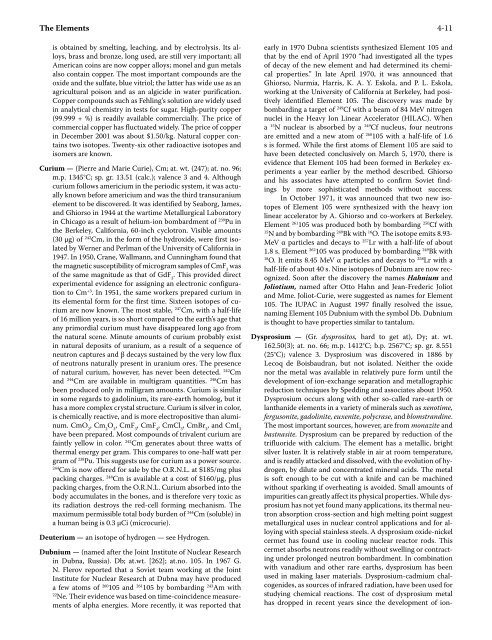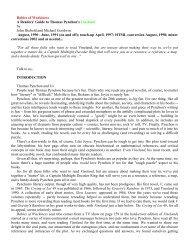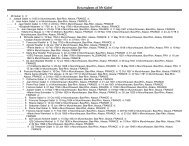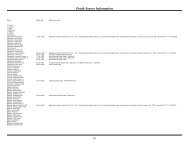CRC Handbook of Chemistry and Physics, 86th Edition
CRC Handbook of Chemistry and Physics, 86th Edition
CRC Handbook of Chemistry and Physics, 86th Edition
Create successful ePaper yourself
Turn your PDF publications into a flip-book with our unique Google optimized e-Paper software.
The Elements 4-11<br />
is obtained by smelting, leaching, <strong>and</strong> by electrolysis. Its alloys,<br />
brass <strong>and</strong> bronze, long used, are still very important; all<br />
American coins are now copper alloys; monel <strong>and</strong> gun metals<br />
also contain copper. The most important compounds are the<br />
oxide <strong>and</strong> the sulfate, blue vitriol; the latter has wide use as an<br />
agricultural poison <strong>and</strong> as an algicide in water purification.<br />
Copper compounds such as Fehling’s solution are widely used<br />
in analytical chemistry in tests for sugar. High-purity copper<br />
(99.999 + %) is readily available commercially. The price <strong>of</strong><br />
commercial copper has fluctuated widely. The price <strong>of</strong> copper<br />
in December 2001 was about $1.50/kg. Natural copper contains<br />
two isotopes. Twenty-six other radioactive isotopes <strong>and</strong><br />
isomers are known.<br />
Curium — (Pierre <strong>and</strong> Marie Curie), Cm; at. wt. (247); at. no. 96;<br />
m.p. 1345°C; sp. gr. 13.51 (calc.); valence 3 <strong>and</strong> 4. Although<br />
curium follows americium in the periodic system, it was actually<br />
known before americium <strong>and</strong> was the third transuranium<br />
element to be discovered. It was identified by Seaborg, James,<br />
<strong>and</strong> Ghiorso in 1944 at the wartime Metallurgical Laboratory<br />
in Chicago as a result <strong>of</strong> helium-ion bombardment <strong>of</strong> 239 Pu in<br />
the Berkeley, California, 60-inch cyclotron. Visible amounts<br />
(30 µg) <strong>of</strong> 242 Cm, in the form <strong>of</strong> the hydroxide, were first isolated<br />
by Werner <strong>and</strong> Perlman <strong>of</strong> the University <strong>of</strong> California in<br />
1947. In 1950, Crane, Wallmann, <strong>and</strong> Cunningham found that<br />
the magnetic susceptibility <strong>of</strong> microgram samples <strong>of</strong> CmF 3 was<br />
<strong>of</strong> the same magnitude as that <strong>of</strong> GdF 3 . This provided direct<br />
experimental evidence for assigning an electronic configuration<br />
to Cm +3 . In 1951, the same workers prepared curium in<br />
its elemental form for the first time. Sixteen isotopes <strong>of</strong> curium<br />
are now known. The most stable, 247 Cm, with a half-life<br />
<strong>of</strong> 16 million years, is so short compared to the earth’s age that<br />
any primordial curium must have disappeared long ago from<br />
the natural scene. Minute amounts <strong>of</strong> curium probably exist<br />
in natural deposits <strong>of</strong> uranium, as a result <strong>of</strong> a sequence <strong>of</strong><br />
neutron captures <strong>and</strong> β decays sustained by the very low flux<br />
<strong>of</strong> neutrons naturally present in uranium ores. The presence<br />
<strong>of</strong> natural curium, however, has never been detected. 242 Cm<br />
<strong>and</strong> 244 Cm are available in multigram quantities. 248 Cm has<br />
been produced only in milligram amounts. Curium is similar<br />
in some regards to gadolinium, its rare-earth homolog, but it<br />
has a more complex crystal structure. Curium is silver in color,<br />
is chemically reactive, <strong>and</strong> is more electropositive than aluminum.<br />
CmO 2 , Cm 2 O 3 , CmF 3 , CmF 4 , CmCl 3 , CmBr 3 , <strong>and</strong> CmI 3<br />
have been prepared. Most compounds <strong>of</strong> trivalent curium are<br />
faintly yellow in color. 242 Cm generates about three watts <strong>of</strong><br />
thermal energy per gram. This compares to one-half watt per<br />
gram <strong>of</strong> 238 Pu. This suggests use for curium as a power source.<br />
244 Cm is now <strong>of</strong>fered for sale by the O.R.N.L. at $185/mg plus<br />
packing charges. 248 Cm is available at a cost <strong>of</strong> $160/µg, plus<br />
packing charges, from the O.R.N.L. Curium absorbed into the<br />
body accumulates in the bones, <strong>and</strong> is therefore very toxic as<br />
its radiation destroys the red-cell forming mechanism. The<br />
maximum permissible total body burden <strong>of</strong> 244 Cm (soluble) in<br />
a human being is 0.3 µCi (microcurie).<br />
Deuterium — an isotope <strong>of</strong> hydrogen — see Hydrogen.<br />
Dubnium — (named after the Joint Institute <strong>of</strong> Nuclear Research<br />
in Dubna, Russia). Db; at.wt. [262]; at.no. 105. In 1967 G.<br />
N. Flerov reported that a Soviet team working at the Joint<br />
Institute for Nuclear Research at Dubna may have produced<br />
a few atoms <strong>of</strong> 260 105 <strong>and</strong> 261 105 by bombarding 243 Am with<br />
22 Ne. Their evidence was based on time-coincidence measurements<br />
<strong>of</strong> alpha energies. More recently, it was reported that<br />
early in 1970 Dubna scientists synthesized Element 105 <strong>and</strong><br />
that by the end <strong>of</strong> April 1970 “had investigated all the types<br />
<strong>of</strong> decay <strong>of</strong> the new element <strong>and</strong> had determined its chemical<br />
properties.” In late April 1970, it was announced that<br />
Ghiorso, Nurmia, Harris, K. A. Y. Eskola, <strong>and</strong> P. L. Eskola,<br />
working at the University <strong>of</strong> California at Berkeley, had positively<br />
identified Element 105. The discovery was made by<br />
bombarding a target <strong>of</strong> 249 Cf with a beam <strong>of</strong> 84 MeV nitrogen<br />
nuclei in the Heavy Ion Linear Accelerator (HILAC). When<br />
a 15 N nuclear is absorbed by a 249 Cf nucleus, four neutrons<br />
are emitted <strong>and</strong> a new atom <strong>of</strong> 260 105 with a half-life <strong>of</strong> 1.6<br />
s is formed. While the first atoms <strong>of</strong> Element 105 are said to<br />
have been detected conclusively on March 5, 1970, there is<br />
evidence that Element 105 had been formed in Berkeley experiments<br />
a year earlier by the method described. Ghiorso<br />
<strong>and</strong> his associates have attempted to confirm Soviet findings<br />
by more sophisticated methods without success.<br />
In October 1971, it was announced that two new isotopes<br />
<strong>of</strong> Element 105 were synthesized with the heavy ion<br />
linear accelerator by A. Ghiorso <strong>and</strong> co-workers at Berkeley.<br />
Element 261 105 was produced both by bombarding 250 Cf with<br />
15 N <strong>and</strong> by bombarding 249 Bk with 16 O. The isotope emits 8.93-<br />
MeV α particles <strong>and</strong> decays to 257 Lr with a half-life <strong>of</strong> about<br />
1.8 s. Element 262 105 was produced by bombarding 249 Bk with<br />
18 O. It emits 8.45 MeV α particles <strong>and</strong> decays to 258 Lr with a<br />
half-life <strong>of</strong> about 40 s. Nine isotopes <strong>of</strong> Dubnium are now recognized.<br />
Soon after the discovery the names Hahnium <strong>and</strong><br />
Joliotium, named after Otto Hahn <strong>and</strong> Jean-Frederic Joliot<br />
<strong>and</strong> Mme. Joliot-Curie, were suggested as names for Element<br />
105. The IUPAC in August 1997 finally resolved the issue,<br />
naming Element 105 Dubnium with the symbol Db. Dubnium<br />
is thought to have properties similar to tantalum.<br />
Dysprosium — (Gr. dysprositos, hard to get at), Dy; at. wt.<br />
162.50(3); at. no. 66; m.p. 1412°C; b.p. 2567°C; sp. gr. 8.551<br />
(25°C); valence 3. Dysprosium was discovered in 1886 by<br />
Lecoq de Boisbaudran, but not isolated. Neither the oxide<br />
nor the metal was available in relatively pure form until the<br />
development <strong>of</strong> ion-exchange separation <strong>and</strong> metallographic<br />
reduction techniques by Spedding <strong>and</strong> associates about 1950.<br />
Dysprosium occurs along with other so-called rare-earth or<br />
lanthanide elements in a variety <strong>of</strong> minerals such as xenotime,<br />
fergusonite, gadolinite, euxenite, polycrase, <strong>and</strong> blomstr<strong>and</strong>ine.<br />
The most important sources, however, are from monazite <strong>and</strong><br />
bastnasite. Dysprosium can be prepared by reduction <strong>of</strong> the<br />
trifluoride with calcium. The element has a metallic, bright<br />
silver luster. It is relatively stable in air at room temperature,<br />
<strong>and</strong> is readily attacked <strong>and</strong> dissolved, with the evolution <strong>of</strong> hydrogen,<br />
by dilute <strong>and</strong> concentrated mineral acids. The metal<br />
is s<strong>of</strong>t enough to be cut with a knife <strong>and</strong> can be machined<br />
without sparking if overheating is avoided. Small amounts <strong>of</strong><br />
impurities can greatly affect its physical properties. While dysprosium<br />
has not yet found many applications, its thermal neutron<br />
absorption cross-section <strong>and</strong> high melting point suggest<br />
metallurgical uses in nuclear control applications <strong>and</strong> for alloying<br />
with special stainless steels. A dysprosium oxide-nickel<br />
cermet has found use in cooling nuclear reactor rods. This<br />
cermet absorbs neutrons readily without swelling or contracting<br />
under prolonged neutron bombardment. In combination<br />
with vanadium <strong>and</strong> other rare earths, dysprosium has been<br />
used in making laser materials. Dysprosium-cadmium chalcogenides,<br />
as sources <strong>of</strong> infrared radiation, have been used for<br />
studying chemical reactions. The cost <strong>of</strong> dysprosium metal<br />
has dropped in recent years since the development <strong>of</strong> ion-







